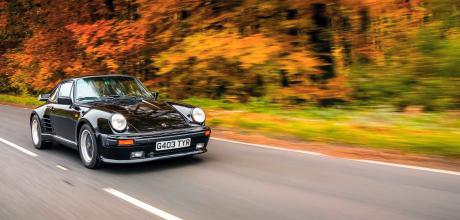1989 Porsche 911 Turbo LE 930
It’s been more than 25 years since the original Turbo ceased production. Total 911 goes behind the wheel of the last 930 and finds a surprisingly modern classic
The Limited Edition Turbo was built to celebrate the end of 930 production, and came with a huge specification.
ULTIMATE 930
911 Turbo: the early years
The lines of the 911 Turbo are combined with the flamboyance of the‘Flachbau’ SEto create the ultimate 930: the 330bhp LE
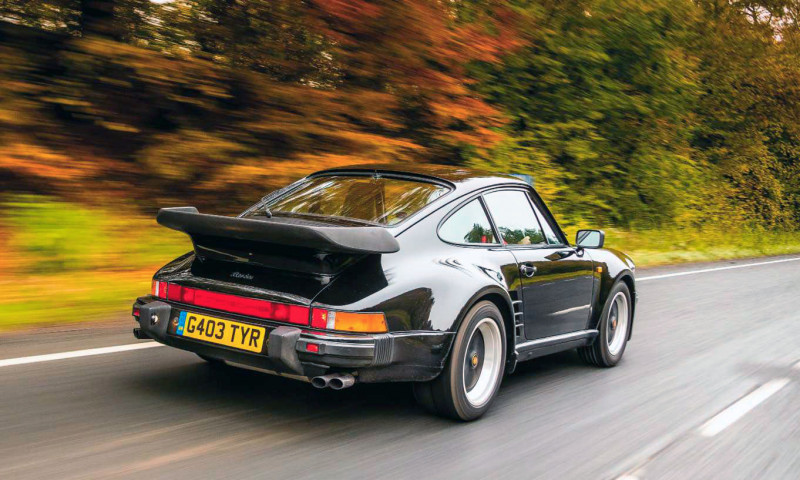
In 2013, the worldwide Porsche community was celebrating one date: September 1963. A year later, fresh off the Porsche 911’s 50th anniversary, attention turned to August 1974. Why? 40 years previously, the first road-going Porsche 911 Turbo was handed over to its new owner, Louise Piech, head of Porsche Austria and daughter of Ferdinand Porsche.
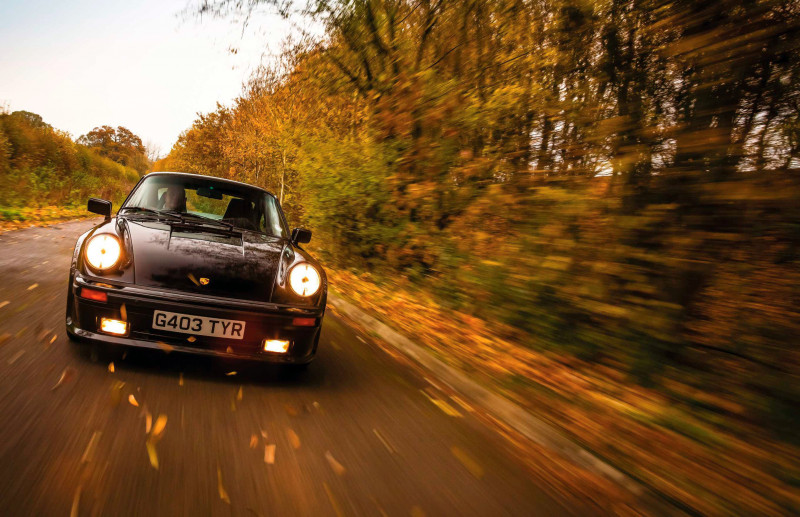
That original 930, devoid of the wide arches that would become synonymous with the car, came with a 2.7-litre engine and was a sports car designed predominantly for comfort. With its narrow body and slender rear wing, Piech’s test vehicle appeared rather sedate. However, underneath the rear deck lay a 250bhp engine.
By the time the first real customers got their hands on this new 911 Turbo in 1975, the rear arches had been flared and the engine’s displacement ramped up to 3.0 litres. Despite the global oil crisis, the 3.0-litre 930 was an instant sales success, with unprecedented demand for the 260bhp sports car. Posters adorned the walls of many a bedroom, and with a 0-60mph time of just 5.5 seconds and top speed of 155mph, the first 911 Turbo was also the first supercar.
However, with a lot of turbo lag, the car’s handling left a lot to be desired, as did the brakes. For 1977, Porsche announced a new 3.3-litre 930, featuring 300bhp and uprated brakes (derived from the cross-drilled 917 discs). The vague four-speed 915 gearbox remained until 1988, when it was replaced by the shorter ratios and more driveable clutch of the G50 five-speed unit.
During this period, the Sonderwunsch programme (later to become Porsche Exclusive) offered a flatnose option in 1981. However, this wasn’t to go into full-scale production until 1986, when the 930 SE was released for general sale. Its uprated 330bhp underpinings would see out the 930 generation with the 50 LE examples produced 25 years ago. Gaining 70bhp and 195kg across its 15-year life, the 930 defined the character that we have come to love with the current generation of 911 Turbos. With its 40th birthday celebrated in 2014, this was a very special year for a very special Zuffenhausen icon.
In 1989, the Porsche 911 was experiencing its greatest overhaul yet, with the 964 platform coming onto production lines. However, the 911 Turbo was not expected to play a part in this revolution. To mark the apparent end for Porsche’s forced-induction 911, Zuffenhausen gave the 930 one last hurrah.
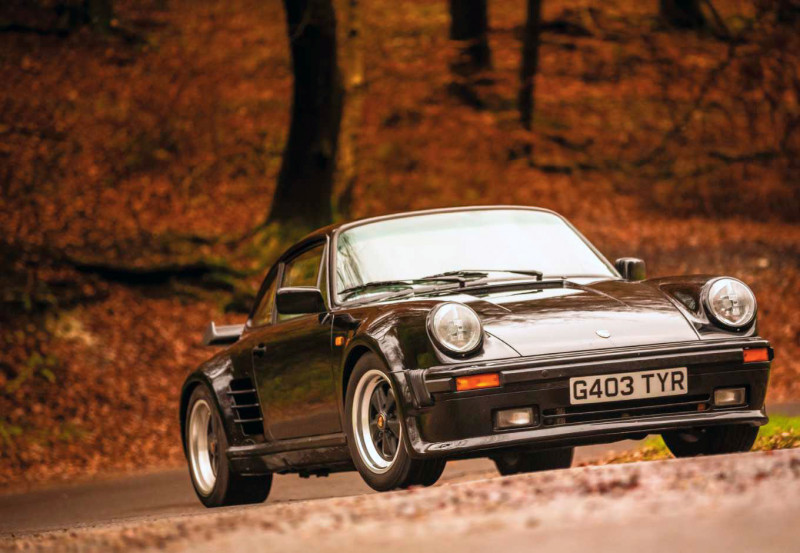
The 930 LE was truly limited edition, with Porsche producing just 50 examples. Each Porsche Centre was limited to just one car, making availability incredibly exclusive, just like the price tag. The original list price for the 930 LE was an eye-watering £84,492.
This gave the 930 LE a price tag of over 50 per cent more than that of the average UK house of the time. If Porsche was to release a 911 similarly priced in comparison to today’s housing market, it would be yours for £254,000. In other words, it wouldn’t happen. Thankfully, the culture of wild excess in the late Eighties made this car a possibility, with Porsche easily selling all 50 examples (although unsurprisingly, the example before me was initially owned by a London-based investment banker).
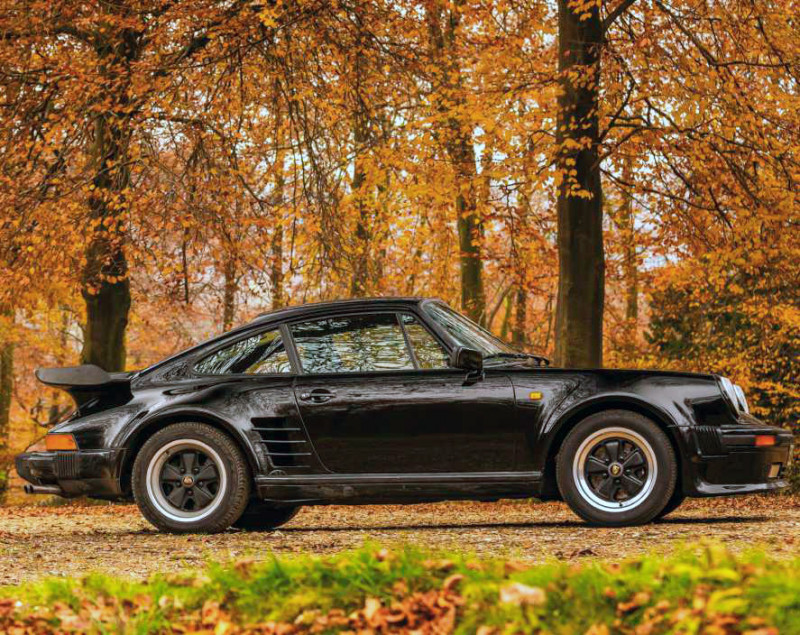
With the 930 LE, Porsche went out of its way to create the ultimate Turbo. Each car started life as a standard 3.3-litre Turbo before being passed over to the ‘Exclusive’ team at Zuffenhausen. Here, each car was rebuilt by hand to include a host of no-cost options, including colour-coded wheel centres and a top-tinted windscreen. What’s more, any colour from the standard range could be used for the body, with colour-to-sample available at an extra cost.
Inside, the choice was similarly expansive, with any combination of standard leather colours possible for the electrically adjustable seats. The use of leather extended to the handbrake gaiter, while the steering wheel was a three-spoke design, similar to the original 1974 Turbo’s. Sitting at its centre was a gold Porsche crest, complemented by a similar emblem on top of the gear knob. A final gold plaque on the centre console highlighted the LE’s place at the end of the Turbo’s rich 15-year tenure as one of the most fearsome sports cars ever produced.
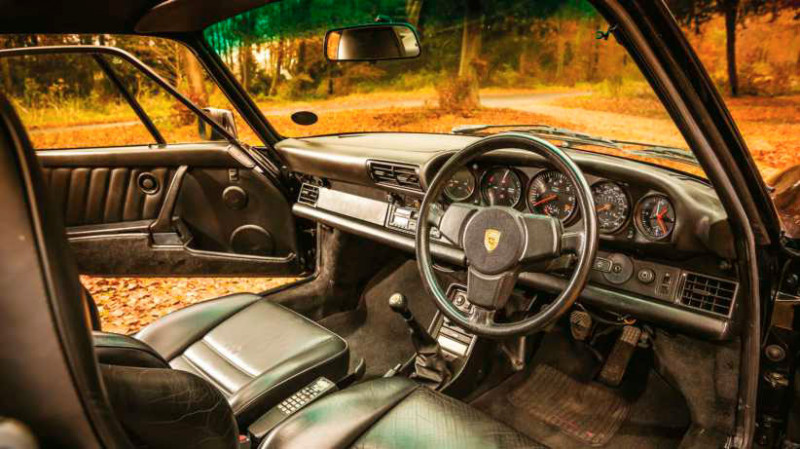
The 930 LE’s interior is intimate yet comfortable. The in-car phone (bottom left) is a symbol of capitalist Eighties culture.
Of course, Porsche couldn’t let the 930 enter the history books without making it just a little bit more formidable. Utilising the SE’s revised intercooler (housed inside an aggressive chin spoiler) power was hiked to 330bhp. Also carried over were the air intakes on the rear arches, while at the back, four tailpipes replaced the standard dual side exits.
In the metal, the black example before me is truly intimidating. Although the 930 LE may lack the sheer size of the current 991 Turbo, it more than makes up for this with its menacing stance and styling. The deep chin spoiler, with its lipped lower edge, is reminiscent of the 934 race car, while the SE brake ducts are unmistakably Eighties with their three horizontal slats. When viewed from the side, the almost-ridiculous end plates on the monstrous tea tray rear wing help to complete the look. The 930 LE’s styling certainly seems to take more than a few cues from the proliferation of tuners that sprung up during the decade.

However, while creations like the Rinspeed R69 and Gemballa Avalanche are gauche by many standards, the Porsche 930 LE is unmistakably 911 in its shape; a perfect balance of exaggeration and style. With its traditional, eye-like front end, the LE is less divisive than its flatnose brother, too.
Yet, it is no less visually arresting. Indeed, alongside the car’s owner, David Newton, it proves impossible for us to not wax lyrical about the alluring lines of the classic-shelled 911, as there isn’t a flat piece of metal on the car. No wonder the Turbo was the poster boy of the Seventies car world when it was unveiled; it’s gorgeous. Despite its innately graceful lines, though, the 930 LE’s Eighties visual embellishments make it one of those rare cars that looks fast sitting at rest. Of course, its rest isn’t going to last much longer.
David bought his 930 LE (one of just 14 right-hand drive examples) at Coys’ Ascot auction and, although he has driven just 90 of the 22,000 or so miles, he is one of those truly effervescent enthusiasts who is happy to hand me his keys, even after I tell him I’ve never driven an air-cooled 911 of any sort on the road, let alone an air-cooled Turbo.
The first thing that hits me as I lower myself into the 930 LE is how snug the interior is. Although this will come as no surprise to those who are accustomed to a classic 911’s charms, the 930 LE’s cockpit is incredibly intimate. The five-dial pods loom large, with the steering wheel taking up a greater part of my view thanks to the cockpit’s cosy layout and wheel’s size. For such a large wheel, the rim is surprisingly thin; perhaps the one part of the interior that doesn’t feel ergonomically correct.
While I don’t have incredibly broad shoulders, the current generation of Porsche seats feel too narrow for my body, with the side bolsters tapering in too sharply. On the 930 LE, though, the classic seat fits like a tailored suit. I fall straight into their luxurious grasp with minimal adjustment, the bolsters holding me exactly where I want without exerting any undue pressure.
They are sublime, instantly making me feel at ease as I spark the 3.3-litre, single turbocharged engine into life. A gruff growl rumbles before settling down to an almost imperceptible level. With the optional shortened gear lever fitted as standard, the separate dogleg that houses reverse feels close to the G50 gearbox’s first gear. After David has shown Zen-like levels of patience, I finally acclimatise myself to the LE’s shift pattern, engage first, and move away.
I nearly don’t manage this, such is the clutch’s severe engagement. Thankfully, pedal travel is plentiful, allowing you to manage the aggressive bite between centre plate and flywheel. With a little bit of throttle and a good degree of practice, pulling away eventually becomes quite civilised.
The same can’t be said for the clutch’s weight, however. Like many high-powered, manual 911s, expect your left leg to get a thorough workout when driving the 930 LE. It’s not for everyone, but I loved the positive feel that such a heavy, aggressive clutch brings, although I’m not sure how happy I would have been if an hour of city driving lay ahead.
Straight onto a dual carriageway, and the LE shows itself to be incredibly modern, despite celebrating its 25th anniversary in 2014. With minimal road noise and only a whiff of the engine note, fifth gear is serene; you’d be forgiven for thinking you were in a car two decades younger. In such an environment, talking to David proves easy, with his passion for the marque proving infectious right away.
“I’d been searching for a 930 LE for several months,” he explains. “I had looked at a slightly higher-mileage example, but it was in poorer condition. Because of the very limited production run – one of the shortest of any production Porsche – choice was somewhat limited.” Thankfully, David (former chairman of the Porsche Club GB) waited before happening upon this truly brilliant example at Coy’s October auction. With the hammer falling at £85,000, he appears to have found himself a relative bargain, with LEs of a similar quality fetching closer to – if not over – the six-figure mark. Back on the road, the suspension is hard without being overly harsh. You can feel the road beneath you, but with nothing like the ferocity of any modern performance car. Similarly, on roads with particularly extreme cambers, the LE will track slightly without trying to rip your shoulders off.
With the car’s rarity sitting quite heavily on my mind (and the fact that the owner was a matter of inches away), I had been wary of driving too exuberantly. However, a 930 with 330bhp is not meant to be driven serenely all the time. Like a modern 911 Turbo, the 930 LE is designed for both speed and comfort. With the road clear of traffic, it’s time for my first taste of classic Turbo power, as David urges me to shift down to third gear and floor the throttle – well, it would now seem rude not to.
I put the lever into third and, despite the slippery tarmac, apply the throttle hard and fast. Nothing. “Wait,” David says. Without the benefit of electronic wizardry or variable turbine geometry, the LE has a good second of turbo lag but, before I have time to fully rationalise the situation, the single turbocharger spools up, the boost gauge races passed 0.5 bar, and I am shoved back into my seat with a ferocity that belies a car of this age.
This 911 is older than I am, yet it gains speed effortlessly. With the Turbo reaching its comfort zone, the car pulls forward at an alarming rate. Despite the five-ratio ’box providing the LE with shorter gears than the previous four-speed Turbos, in true Porsche fashion the gears are still ridiculously – and fantastically – long. Third gear is enough to break every speed limit around. During this brutal acceleration, the sound of the aircooled engine is magical. It is full of character, despite being inevitably muffled by the turbocharger. While the current 991 Turbo still has a brilliant tone at high revs, the 930 LE’s engine note is more mechanical and real. It is almost as if you can hear every component at work in the 3,299cc powerplant, before unburned fuel starts to crackle in the exhaust during the over-run.
The combination of speed and sound is addictive. “Is this your first Turbo?” I ask David. “This is my very first Turbo,” he explains. “Back when they were new, I was aware that if I had driven one, I would have wanted one, as the ultimate power on offer is a very corruptible thing.” It’s the perfect term for the brand of speed that the LE displays. It’s like a drug; you want to keep racing for the redline, and I wasn’t expecting this from a classic.
Off the dual carriageway, and the 930 LE is a formidable back road weapon, too. While it was certainly no lightweight at the time, its 1,335 kilograms feel lively, aided by the communicative unassisted steering. Everything you feel through the steering is, like the engine sound, organic. You are kept in constant dialogue with the front tyres and, despite the rain on our test, the LE doesn’t understeer at fast speeds. Yes, it squats back under acceleration, but the front end never feels light. It invites confidence on corner entry, even if the brakes don’t.
The brake pedal always feels like it is rolling away from your foot, al‹though you get used to the sensation. This is pure classic 911 territory. Luckily, the pedal isn’t very long, and offers a good feel, meaning heavy braking is possible without the help of ABS.
With prior knowledge of the turbo lag, cornering isn’t as intimidating as the 930 legends make out. If you are sensible with your mid-corner throttle application, you can avoid an unwanted maelstrom of power. It takes some getting used to but, once you master it, you can get on the throttle earlier than you would in a naturally aspirated 911, spooling up the Turbo before heading towards the next curve.
On these roads, the 930’s dashboard layout proves invaluable. The boost gauge is inset into the centrally mounted rev counter, giving me a single focal point on the two dials I need to watch. Perennially checking the boost lets you anticipate the moment 330bhp is unleashed upon the rear wheels, while the rev counter is forever sprinting towards 6,700rpm and that next gear change.
With the shortened lever, the vagueness exhibited by many classic Porsche gearboxes is reduced. However, rushing between gears only makes the gear change feel notchy as you beat the slightly lazy syncromesh. Relaxing slightly makes shifts more positive and enjoyable. Changing gear in the 930 LE needs to be an embodiment of the car’s character: controlled mechanical aggression.
Away from the on-boost setting of the country roads, the LE reverts back to its perfectly poised persona as we enter town. Yes, the clutch is heavy, and the steering wheel proving vital for low-speed manoeuvring, but the car is sedate. Just like the new 911 Turbo, the 930 LE can seamlessly switch between comfort and aggression, and often offers both simultaneously.
The 930 LE was not a money spinning run-out produced by Porsche’s bean-counters; it was an engineering marvel that feels solid enough to be marketed on the forecourts of 2014. As David perfectly sums up, “It’s got that classic Porsche ‘hewn from rock’ feel to it.” The idiosyncratic turbo lag may be a thing of the past, but the 930 LE’s overarching modernity may just make this the perfect everyday classic.
TECHNICAL DATA1989 Porsche 911 Turbo LE 930
- Model Porsche 911 930 LE
- Year 1989
Engine
- Capacity 3,299cc
- Compression ratio 7.0:1
- Maximum power 330bhp @ 5,500rpm
- Maximum torque 432Nm @ 4,000rpm
Transmission
- G50 five-speed
Suspension
- Front Independent MacPherson struts; longitudinal torsion bars; antiroll bar; telescopic dampers.
- Rear Independent semi-trailing arms; transverse torsion bars; double acting telescopic dampers
Wheels & tyres
- Front 7x16-inch Fuchs, 205/55 VR16 tyres
- Rear 9x16-inch Fuchs, 245/45 VR16 tyres
Brakes
- Front 304mm cross-drilled discs
- Rear 309mm cross-drilled discs
Dimensions
- Length 4,491mm
- Width 1,775mm
- Weight 1,335kg
Performance
- 0-62mph 4.6 secs
- Top speed 173mph


